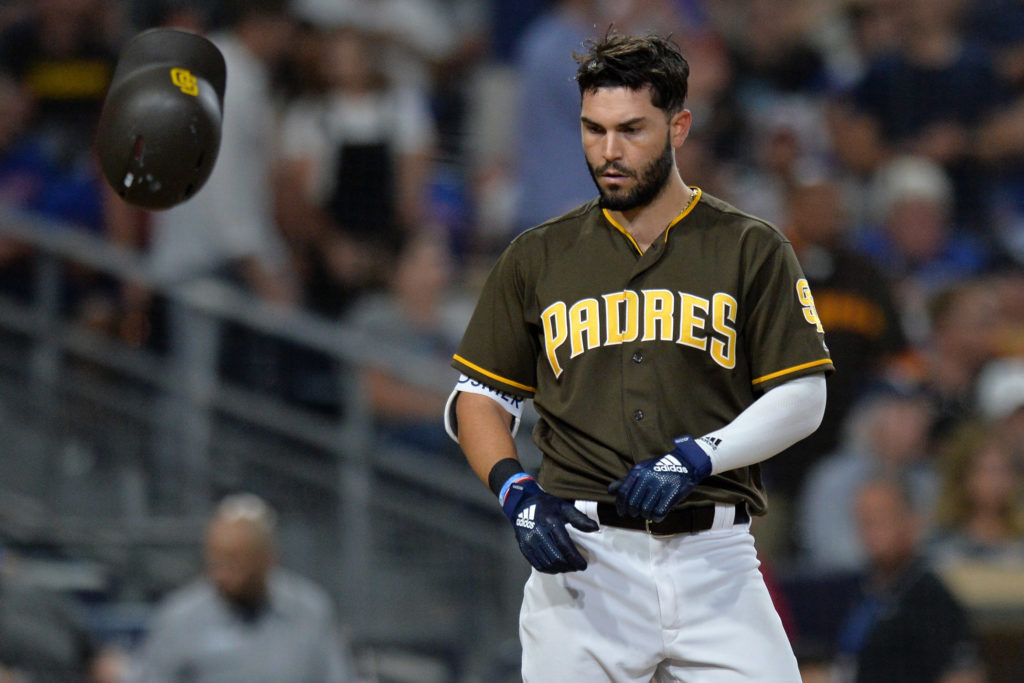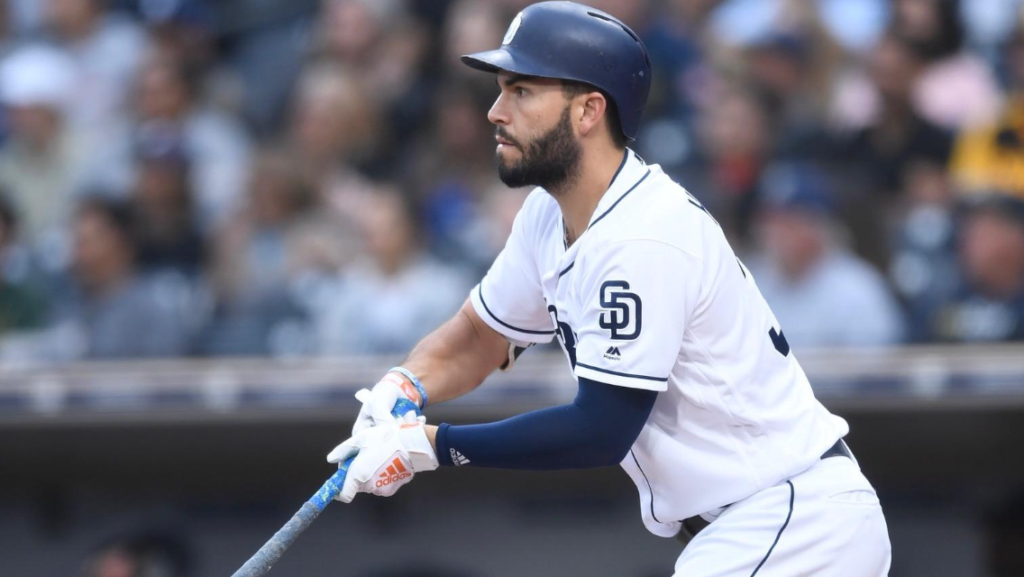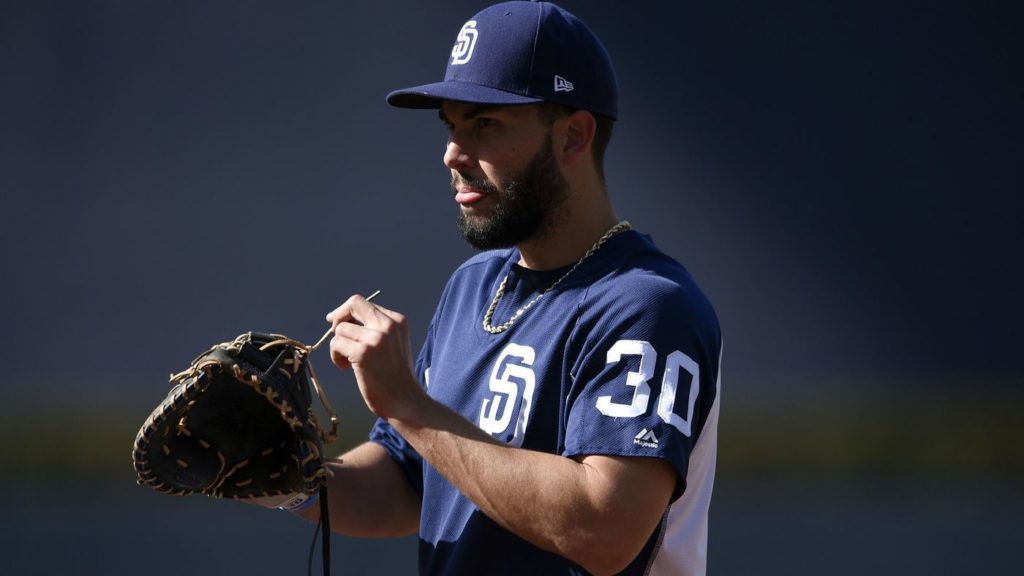Investigating Eric Hosmer’s Strange Odd-Year Trend

Mandatory Credit: Jake Roth-USA TODAY Sports

San Diego Padres’ first baseman Eric Hosmer is looking for a bounce-back year after a disappointing debut. His career trend suggests that may happen in 2019.
Eric Hosmer was a disappointment in 2018, there is no other way to slice it.
San Diego signed him to an eight-year, $144 million contract last February and earned $21 million last season. That is a substantial amount of money to pay a player who had a .253 average, a career-high 21% strikeout rate and a 95 wRC+, which means he was a slightly below-average hitter.
There is a strange trend when looking at Hosmer’s eight-year career.
He is prone to down years like he had in 2018, the puzzling thing about it is that it always occurs during even years, while Hosmer rebounds in odd years.
Let’s dive a little deeper into this trend.
| Averages of Even Years (2012, 2014, 2016, 2018) | |
| Batting Avg | 0.255 |
| OPS | 0.715 |
| wRC+ | 94 |
| Games Played | 150 |
| Gold Gloves won | 1 |
| Total WAR | 2.9 |
| Averages of Odd Years (2011, 2013, 2015, 2017) | |
| Average | 0.303 |
| OPS | 0.826 |
| wRC+ | 123 |
| Avg games played | 152 |
| Gold Gloves won | 3 |
| Total WAR | 12.6 |
There is, without a doubt, a clear, marked difference here. Even-year Hosmer is average at best, but mostly below-average. The 94 wRC+ suggests he is 6% below league average for hitters and a .255 average confirms that.
What in the world happens between even and odd years? If someone strictly had the stats of Hosmer’s odd years over the course of a decade, we would all be discussing whether or not he is a first ballot Hall of Famer. He averages a 123 wRC+ in odd years. Here are a few players who didn’t even reach that in 2018 alone: Cody Bellinger, Didi Gregorius, George Springer, and Charlie Blackmon, two of those guys being All-Stars last season.
That is like going from Kurt Suzuki at the plate to Justin Upton.
His batting average climbs an astounding 48 points. He plays in slightly more games. Even his defense seems to ride this trend, as he has won three-quarters of his four Gold Gloves during odd years.
Perhaps the most mind-blowing of these numbers is the fact that Hosmer is almost ten wins better in odd years. Incredible.
The Kansas City Royals even lost the World Series in an even year, to the Giants in 2014, only to rebound themselves in 2015 to win it all.

So what causes this? Does he get complacent after a good year and slack off, only to get motivated by that bad year and rebound the next? My name is not Eric Hosmer so I can’t answer that. His BABIP has always hovered just above .300, so it’s not bad luck at play.
Hosmer seems to hit more line drives in odd years for whatever reason, averaging a 22% line drive rate in odd years, which drops to 18% in even years. He is not being pitched any differently, as the numbers suggest he has seen about the same amount of fastballs and breaking balls throughout his career.
Let’s look at 2012 to 2013 as a possible measuring stick. 2012 is still the worst season of his career, even after 2018. He hit .232 with a .663 OPS and an 80 wRC+, all career lows. This was after his stellar rookie season where he finished third in Rookie of the Year voting.
Then in 2013, after that awful 2012, his batting averaged soared up to .302 with a .801 OPS and a 120 wRC+, the third-highest of his career.
If we applied that same jump to 2019, Hosmer would be in the range of a .320 average and 135 wRC+, which is of course, absurd, but it paints the picture of how inconsistently consistent Hosmer has been and just how dramatic of a change it can be year to year.
FanGraphs projects Hosmer to hit .265 with a 110 wRC+ and 22 home runs, which would be yet another big rebound.
There is no guarantee Hosmer will rebound as he has in the past, baseball is a cruel game, but often the past can predict the future to an extent when the sample size is large enough. Four even years and four odd years is a decent sample size to go off of. That’s when it becomes a trend, not an anomaly.
Good thing 2019 is an odd year.
Native of Escondido, CA. Lived in San Diego area for 20 years. Padres fan since childhood (mid-90s). I have been writing since 2014. I currently live near Seattle, WA and am married to a Seattle sports girl. I wore #19 on my high school baseball team for Tony Gwynn. I am a stats and sports history nerd. I attended BYU on the Idaho campus. I also love Star Wars.
Think of how different this team would be if AJ had not committed Preller’s Folly and signed Hosmer?
First base would NOT be a disadvantage; instead it would be an advantageous spot where Myers or others could play (e.g. Reyes, who powerful bat might otherwise not be able to play); we would likely be excitingly looking forward to Josh Naylor playing there in a year or two (as opposed to forcing him out of position, and decreasing his value to the team, and likely hurting his own career); the Padres would have $20+ million per year/$144 million overall to spend on other assets of actual value (perhaps Machado, Harper, etc); because he is paid at such an outrageous and absurd amount, the Padres apparently are forced to play this inferior-and-massively-overpaid player, instead of a multitude of better players; the log jam in the OF would be greatly eased; the team would be greatly improved this year, and for the next several years!
Thanks AJ!
I agree. This signing was embarrassingly dumb. But which was worse, the Hosmer signing or the Preller extension? A ton of the blame belongs with Ron “foul ball” Fowler, who has to be one of the least knowledgeable owners. After all that happened he goes ahead and extends Preller. Then he okays the Hosmer deal.
If Fowler was a batter he’d be the type who fouls off a pitch right into his groin. Every at bat.
Good article. This pattern was known of course, making the signing all the more odd. This guy needs to change his swing or be platooned, since he can’t be traded.
Nice article. He should be riding the pine against LHPs, if not this year then in the next year or two.